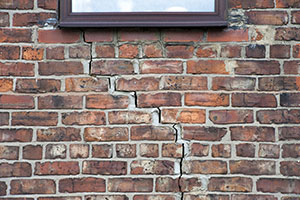Subsidence is often perceived as a nightmare scenario by social housing providers, who fear the disruption and cost of having to get it treated. However, fixing subsidence needn’t be a massive headache. The latest technology uses expanding geopolymer resin that is injected into the ground through small holes, meaning tenants can stay in their home while work is carried out.
What is subsidence and what causes it?
Subsidence is when the ground underneath a property can no longer support the weight of the building and as a result, the building begins to sink into the ground. Often this is just on one side, causing the property to lean and cracks to appear in the walls.
There are various causes of subsidence. Firstly, it can be due to the properties of the soil found beneath a building. For example, if the local soil is a clay soil, this can expand and contract with changes in temperature, which can cause a home’s foundations to sink. Alternatively, sand and gravel based soils can be washed away by flooding, heavy rainfall or broken drains, causing voids to form beneath a house.
Other causes of subsidence can include tree roots, nearby construction work, historic mineshafts and vibrations from nearby traffic. You can read more about the causes of subsidence in this guide from Geobear.
How can you tell if a building is suffering from subsidence?
There are various visual indicators of subsidence, such as cracks in the wall that are visible from both inside and outside, as well as visible leaning of the property and sticking windows and doors. However, some of these things may also be due to other issues or the normal settlement of a building. If you suspect a property may have subsidence, then you should get a surveyor to come and assess the building. You can find a surveyor near you through the RICS website.
You can also see whether homes are likely to be at risk of subsidence due to local soil types or other factors. These free subsidence maps from Geobear show areas that are at greater risk.
What to do if your social housing property has subsidence
If one or more of your properties is experiencing subsidence, this needs remedying as soon as possible. If left untreated, subsidence will only worsen, with damage to the property increasing by the day. In addition, it can cause safety issues for tenants.
The traditional method of treating subsidence is underpinning, whereby the ground below the property is excavated and the foundations reinforced with concrete or steel. This can cause big issues for social housing providers, as the process can take weeks to months, during which time tenants will need to vacate the property. With council housing in short supply and long waiting lists already, rehousing tenants can be extremely tricky. As well  as this, temporary housing and the work itself can cost providers a lot of money.
as this, temporary housing and the work itself can cost providers a lot of money.
Luckily, there is another solution. The latest innovation in subsidence technology is geopolymer resin injection. This process merely requires the creation of some small holes in the ground at strategic points, through which a special resin is injected. Once below the ground, this special geopolymer material expands and hardens, filling any voids and compacting soil in order to strengthen it. The beauty of this method is that it is much faster than underpinning and can be carried out whilst tenants stay in their homes.
This patented technique is provided by the company Geobear, who have worked on behalf of numerous local authorities and housing providers across the UK to quickly and efficiently fix subsidence in social housing.
- Log in to post comments















